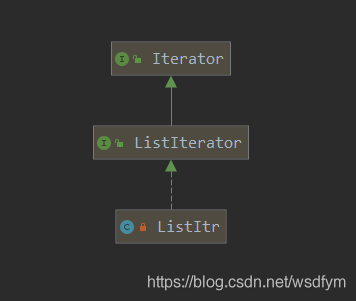List的remove()方法陷阱+性能优化
文章目录
- 几种常见方法
- 性能分析
- 使用迭代器的方法删除元素
- 原理 重点看一下LinkedList的迭代器
- 先看看list.remove(idnex)是怎么处理的
- 迭代器的处理
Java List在进行remove()方法是通常容易踩坑,主要有一下几点
循环时:问题在于,删除某个元素后,因为删除元素后,后面的元素都往前移动了一位,而你的索引+1,所以实际访问的元素相对于删除的元素中间间隔了一位。
几种常见方法
1.使用for循环不进行额外处理时(错误)
//错误的方法
for(int i=0;i<list.size();i++) {
if(list.get(i)%2==0) {
list.remove(i);
}
}
2.使用foreach循环(错误)
for(Integer i:list) {
if(i%2==0) {
list.remove(i);
}
}
抛出异常:java.util.ConcurrentModificationException;
foreach的本质是使用迭代器实现,每次进入for (Integer i:list) 时,会调用ListItr.next()方法;
继而调用checkForComodification()方法, checkForComodification()方法对操作集合的次数进行了判断,如果当前对集合的操作次数与生成迭代器时不同,抛出异常
public E next() {
checkForComodification();
if (!hasNext()) {
throw new NoSuchElementException();
}
lastReturned = next;
next = next.next;
nextIndex++;
return lastReturned.item;
}
// checkForComodification()方法对集合遍历前被修改的次数与现在被修改的次数做出对比
final void checkForComodification() {
if (modCount != expectedModCount) {
throw new ConcurrentModificationException();
}
}
3.使用for循环,并且同时改变索引;(正确)
//正确
for(int i=0;i<list.size();i++) {
if(list.get(i)%2==0) {
list.remove(i);
i--;//在元素被移除掉后,进行索引后移
}
}
4.使用for循环,倒序进行;(正确)
//正确
for(int i=list.size()-1;i>=0;i--) {
if(list.get(i)%2==0) {
list.remove(i);
}
}
5.使用while循环,删除了元素,索引便不+1,在没删除元素时索引+1(正确)
//正确
int i=0;
while(i<list.size()) {
if(list.get(i)%2==0) {
list.remove(i);
}else {
i++;
}
}
6.使用迭代器方法(正确,推荐)
只能使用迭代器的remove()方法,使用列表的remove()方法是错误的
//正确,并且推荐的方法
Iterator<Integer> itr = list.iterator();
while(itr.hasNext()) {
if(itr.next()%2 ==0)
itr.remove();
}
性能分析
下面来谈谈当数据量过大时候,需要删除的元素较多时,如何用迭代器进行性能的优化,对于ArrayList这几乎是致命的,从一个ArrayList中删除批量元素都是昂贵的时间复杂度为O(n²),那么接下来看看LinkeedList是否可行。LinkedList暴露了两个问题,一个:是每次的Get请求效率不高,而且,对于remove的调用同样低效,因为达到位置I的代价是昂贵的。
- 每次的Get请求效率不高:需要先get元素,然后过滤元素。比较元素是否满足删除条件。
- remove的调用同样低效:
LinkedList的remove(index),方法是需要先遍历链表,先找到该index下的节点,再处理节点的前驱后继。
以上两个问题当遇到批量级别需要处理时时间复杂度直接上升到O(n²)
使用迭代器的方法删除元素
对于LinkedList,对该迭代器的remove()方法的调用只花费常数时间,因为在循环时该迭代器位于需要被删除的节点,因此是常数操作。对于一个ArrayList,即使该迭代器位于需要被删除的节点,其remove()方法依然是昂贵的,因为数组项必须移动。下面贴出示例代码以及运行结果

public class RemoveByIterator {
public static void main(String[] args) {
List<Integer> arrList1 = new ArrayList<>();
for(int i=0;i<100000;i++) {
arrList1.add(i);
}
List<Integer> linList1 = new LinkedList<>();
for(int i=0;i<100000;i++) {
linList1.add(i);
}
List<Integer> arrList2 = new ArrayList<>();
for(int i=0;i<100000;i++) {
arrList2.add(i);
}
List<Integer> linList2 = new LinkedList<>();
for(int i=0;i<100000;i++) {
linList2.add(i);
}
removeEvens(arrList1,"ArrayList");
removeEvens(linList1,"LinkedList");
removeEvensByIterator(arrList2,"ArrayList");
removeEvensByIterator(linList2,"LinkedList");
}
public static void removeEvensByIterator(List<Integer> lst ,String name) {//利用迭代器remove偶数
long sTime = new Date().getTime();
Iterator<Integer> itr = lst.iterator();
while(itr.hasNext()) {
if(itr.next()%2 ==0)
itr.remove();
}
System.out.println(name+"使用迭代器时间:"+(new Date().getTime()-sTime)+"毫秒");
}
public static void removeEvens(List<Integer> list , String name) {//不使用迭代器remove偶数
long sTime = new Date().getTime();
int i=0;
while(i<list.size()) {
if(list.get(i)%2==0) {
list.remove(i);
}else {
i++;
}
}
System.out.println(name+"不使用迭代器的时间"+(new Date().getTime()-sTime)+"毫秒");
}
}
原理 重点看一下LinkedList的迭代器
引申阅读:https://blog.csdn.net/wsdfym/article/details/109633368
调用方法:list.iterator();

重点看下remove方法
private class ListItr implements ListIterator<E> {
//返回的节点
private Node<E> lastReturned;
//下一个节点
private Node<E> next;
//下一个节点索引
private int nextIndex;
//修改次数
private int expectedModCount = modCount;
ListItr(int index) {
//根据传进来的数字设置next等属性,默认传0
next = (index == size) ? null : node(index);
nextIndex = index;
}
//直接调用节点的后继指针
public E next() {
checkForComodification();
if (!hasNext())
throw new NoSuchElementException();
lastReturned = next;
next = next.next;
nextIndex++;
return lastReturned.item;
}
//返回节点的前驱
public E previous() {
checkForComodification();
if (!hasPrevious())
throw new NoSuchElementException();
lastReturned = next = (next == null) ? last : next.prev;
nextIndex--;
return lastReturned.item;
}
/**
* 最重要的方法,在LinkedList中按一定规则移除大量元素时用这个方法
* 为什么会比list.remove效率高呢;
*/
public void remove() {
checkForComodification();
if (lastReturned == null)
throw new IllegalStateException();
Node<E> lastNext = lastReturned.next;
unlink(lastReturned);
if (next == lastReturned)
next = lastNext;
else
nextIndex--;
lastReturned = null;
expectedModCount++;
}
public void set(E e) {
if (lastReturned == null)
throw new IllegalStateException();
checkForComodification();
lastReturned.item = e;
}
public void add(E e) {
checkForComodification();
lastReturned = null;
if (next == null)
linkLast(e);
else
linkBefore(e, next);
nextIndex++;
expectedModCount++;
}
}
LinkedList 源码的remove(int index)的过程是
先逐一移动指针,再找到要移除的Node,最后再修改这个Node前驱后继等移除Node。如果有批量元素要按规则移除的话这么做时间复杂度O(n²)。但是使用迭代器是O(n)。
先看看list.remove(idnex)是怎么处理的
LinkedList是双向链表,这里示意图简单画个单链表
比如要移除链表中偶数元素,先循环调用get方法,指针逐渐后移获得元素,比如获得index = 1;指针后移两次才能获得元素。
当发现元素值为偶数是。使用idnex移除元素,如list.remove(1);链表先Node node(int index)返回该index下的元素,与get方法一样。然后再做前驱后继的修改。所以在remove之前相当于做了两次get请求。导致时间复杂度是O(n)。


继续移除下一个元素需要重新再走一遍链表(步骤忽略当index大于半数,链表倒序查找)

以上如果移除偶数指针做了6次移动。
- 删除2节点: get请求移动1次,
remove(1)移动1次。 - 删除4节点: get请求移动2次,
remove(2)移动2次。
迭代器的处理
迭代器的next指针执行一次一直向后移动的操作。一共只需要移动4次。当元素越多时这个差距会越明显。整体上移除批量元素是O(n),而使用list.remove(index)移除批量元素是O(n²)

网站声明:如果转载,请联系本站管理员。否则一切后果自行承担。
- 上周热门
- 银河麒麟添加网络打印机时,出现“client-error-not-possible”错误提示 1507
- 银河麒麟打印带有图像的文档时出错 1426
- 银河麒麟添加打印机时,出现“server-error-internal-error” 1217
- 统信操作系统各版本介绍 1137
- 统信桌面专业版【如何查询系统安装时间】 1134
- 统信桌面专业版【全盘安装UOS系统】介绍 1090
- 麒麟系统也能完整体验微信啦! 1046
- 统信【启动盘制作工具】使用介绍 697
- 统信桌面专业版【一个U盘做多个系统启动盘】的方法 639
- 信刻全自动档案蓝光光盘检测一体机 545
- 本周热议
- 我的信创开放社区兼职赚钱历程 40
- 今天你签到了吗? 27
- 信创开放社区邀请他人注册的具体步骤如下 15
- 如何玩转信创开放社区—从小白进阶到专家 15
- 方德桌面操作系统 14
- 我有15积分有什么用? 13
- 用抖音玩法闯信创开放社区——用平台宣传企业产品服务 13
- 如何让你先人一步获得悬赏问题信息?(创作者必看) 12
- 2024中国信创产业发展大会暨中国信息科技创新与应用博览会 9
- 中央国家机关政府采购中心:应当将CPU、操作系统符合安全可靠测评要求纳入采购需求 8

